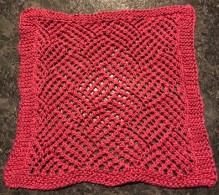For several years I’ve been following Kate Davies’s blog, “Fabrickated.” London-based Kate has a “real” job, but among other talents, she is a skilled and creative clothing  designer/maker with a keen eye for assessing fashion. Kate’s mission always seemed to share how to insert color and classic styling into the minds of those who like to make their own clothes – and those who don’t – but wonder why they might not look “nice.” So I was not surprised by the title of Kate’s first book, “Making life more beautiful: A makers’ handbook.”
designer/maker with a keen eye for assessing fashion. Kate’s mission always seemed to share how to insert color and classic styling into the minds of those who like to make their own clothes – and those who don’t – but wonder why they might not look “nice.” So I was not surprised by the title of Kate’s first book, “Making life more beautiful: A makers’ handbook.”
First, kudos to Kate! She doesn’t back away from the criticality of dressing well; clothing matters. She notes: “They are the first thing others see when they meet us. The viewer makes a judgement based on what you look like, even if you believe this is shallow or unfair” (p87).
Are you asking yourself is this really important? Um, in a word, YES – if you would like to avoid an appearance that screams you don’t own a mirror and are proud of it.
Kate wrote this book for those “who want to make themselves more beautiful by understanding colour and style” (p6). She tackles the subject without making a reader who might be weak in those areas feel depressed or embarrassed.
Kate understands – probably better than most – the pressure on women to dress a certain way, to attain a certain look, to “look good” (which is alone subjective and empty). Yet throughout the book she urges women to celebrate their individuality, confident in their natural beauty.
Yes, Kate’s premise is that every woman has natural beauty; her goal is to help identify, acknowledge and celebrate it through a reasoned and artful use of styles and colors. Thus Kate works to help women identify and celebrate their individuality in a way that is neither over- nor under-dressed, in a way that is comfortable and individual yet artistic and beautiful.
Kate takes a stance against lemming-like fashion waves in the book’s first section, “Beauty.” Here she encourages the reader to “revisit survivalist theories of beauty” (p16) and instead explore “uniqueness … [that] might boost our self-esteem, and become more beautiful by celebrating our unique individuality.” (Far more eloquent and much more focused than the “you go, girl” cry.)
To guide the reader as she searches for authenticity in her clothes (with positive words and pictorial examples modeled by real women, each of whom seems to glow with her confident sense of uniqueness and beauty), Kate breaks down and explores three key elements: natural coloring (6 of them), basic body shape (4 of them) and wardrobe/personal style (5 of them). For each coloring, the reader learns what colors, hues, neutrals, and patterns work best for casual, work and evening wear. For each body style, Kate shares what styles work best and, more importantly, explains why. Her suggestions on wardrobe/personal style allow ample room for individuality.
Kate also introduces (with a nod to Dior), the “four key colours approach.” Why? Because Kate believes that “[k]nowing what works best will help you build your wardrobe so everything you wear enhances your personal colouring, and goes well with everything else” (p44).
Notice the words Kate uses: build (this is not about emptying your closet, running to a store and refilling) and enhance (not camouflage or change). As I walked through airports several times this week, I paid attention to what my fellow travelers were wearing. I wished there were someway I could direct them to Kate’s book. [sigh]
A sensitive subject for most women is body shape. Remember, Kate starts from the premise that the reader is already uniquely beautiful but may not know the best ways to use color and clothing to bring out and celebrate her beauty in unique and confident ways. Thus Kate seeks to assist the reader identify her “basic silhouette rather than look at how much you weigh” so that “you can develop your understanding of what can be done to enhance your natural contours” (p50). Kate also explains how to downplay or draw attention to various parts of one’s body for the purpose of achieving “an illusion of perfect balance” (p58), a balance that is aesthetically pleasing.
On the heels of Kate’s discussion of body shapes is wardrobe. She briefly but critically looks at five clothing preferences or wardrobe “personalities” and then explores how to make a “capsule” wardrobe for each personality. (A capsule wardrobe is, according to Wikipedia, “a collection of a few essential items of clothing that don’t go out of fashion, such as skirts, trousers, and coats, which can then be augmented with seasonal pieces.”)
The second section of the book is titled “Making” as Kate hopes that her “book may also appeal to people who have never tried to make textiles or garments and would like to know how” (p6). I do not believe, however, that this book is a good primer for beginners who want to try their hand making textiles or garments, though it will serve as a colorful, straightforward encouragement to those who would like to try that. Kate, in fact, urges interested readers to take a class or ask a skilled friend for tutoring. I would strongly dissuade a reader without some previous experience attempting Kate’s patterns.
I’ve been reading Kate’s enthusiastic posts about learning how to knit and was not surprised that she took to it so readily. Her background in textile design and pattern making guaranteed she’d want well-fitted knitted garments and would have an idea of how to structurally achieve them. That said, writing good knitting patterns is a separate skill set. Kate’s knitting patterns would be aided, for one, by good schematics. The schematic for the Sleeveless Jumper Pattern,” for instance, lacks measurements, and the “Colorful Yoke Sweater” has no schematic at all. While her “Pencil Skirt” has a good schematic, undoubtedly reflecting her experience and comfort with sewed clothing design, the other sewing patterns have no schematics.
That Making Life Beautiful isn’t yet another narrowly focused “how to” book is to be applauded. Kate approaches the topic with a broad view and directs the reader toward what she could do or might try. There are no detailed, pictorial instructions on, for instance, how to cast on, sew a seam, make a double crochet or iron silk.
In the last and shortest section of her book – “Life” – Kate offers suggestions (and reasons) to establish and maintain a creative space in which to develop one’s creative senses. She is not an isolationalist; she focuses on community(ies), both face-to-face and virtual, that are born out of neighborhoods, social media and globalization. Better yet, she comes up with several ways creative people can connect and exchange ideas with other creative people.
Kate’s book is not a thick tome; it is 105 pages, clearly written, well laid out and filled with delightful, colorful photographs. Throughout, Kate’s words are encouraging and positive, and her inclusion of the wonderful photographs captures the essence of “a picture is worth a thousand words.” Her models are not professional clothes hangers but rather women she interacts with professionally, socially and/or personally. Of varying ethnicities, ranging from teenagers to Kate’s mother, the women are beautiful, unique and hold themselves with confidence, clearly capturing Kate’s ethos of making life more beautiful.
 A special treat was a package of Oreos, the chocolate cookies sandwiched around a sweet “cream” filling. Developed and trademarked in 1912 in New York City, there are probably few children in the U.S. who are unfamiliar with Oreos.
A special treat was a package of Oreos, the chocolate cookies sandwiched around a sweet “cream” filling. Developed and trademarked in 1912 in New York City, there are probably few children in the U.S. who are unfamiliar with Oreos.




 designer/maker with a keen eye for assessing fashion. Kate’s mission always seemed to share how to insert color and classic styling into the minds of those who like to make their own clothes – and those who don’t – but wonder why they might not look “nice.” So I was not surprised by the title of Kate’s first book, “
designer/maker with a keen eye for assessing fashion. Kate’s mission always seemed to share how to insert color and classic styling into the minds of those who like to make their own clothes – and those who don’t – but wonder why they might not look “nice.” So I was not surprised by the title of Kate’s first book, “ … a nice top for warm weather (whenever that will be).
… a nice top for warm weather (whenever that will be). – no surprise given its fiber content – feels a bit like straw (and it’s so easy to split the 4-ply yarn while knitting!), but I think once washed a few times the blouse will soften up nicely.
– no surprise given its fiber content – feels a bit like straw (and it’s so easy to split the 4-ply yarn while knitting!), but I think once washed a few times the blouse will soften up nicely. released her pattern for a beautifully-cabled vest with an origami-like structure: Cahal. I immediately bought it. I will have to see what my gauge swatch reveals … will the soft alpaca-merino set off the beautiful cabling?
released her pattern for a beautifully-cabled vest with an origami-like structure: Cahal. I immediately bought it. I will have to see what my gauge swatch reveals … will the soft alpaca-merino set off the beautiful cabling?







 With the memory of mormor’s havrekjeks dancing in my mind, I felt an urgent need to bake some. I even had the red-wrapped goat cheese already waiting in the refrigerator, ready to be sliced.
With the memory of mormor’s havrekjeks dancing in my mind, I felt an urgent need to bake some. I even had the red-wrapped goat cheese already waiting in the refrigerator, ready to be sliced.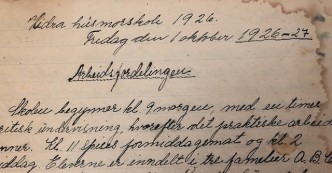 I carefully unearthed mormor’s handwritten cookbook. The book is a collection of recipes and instructions from her time in
I carefully unearthed mormor’s handwritten cookbook. The book is a collection of recipes and instructions from her time in 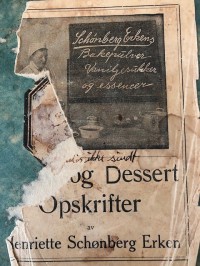 Her book even has a picture of the once well-known
Her book even has a picture of the once well-known 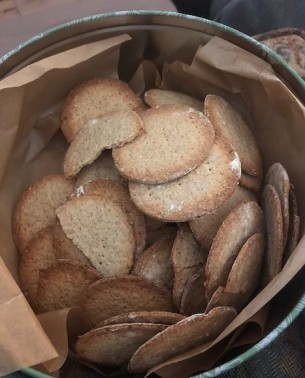 As I particularly like both rye and anise, I incorporate them into my now go-to havrekjeks from mormor’s recipe. (At the end of her instructions for havrekjeks, mormor writes “stikkes over med en gaffel” so if you look closely you’ll see the havrekjeks have marks from fork tines, which allows steam to escape as the crackers bake.)
As I particularly like both rye and anise, I incorporate them into my now go-to havrekjeks from mormor’s recipe. (At the end of her instructions for havrekjeks, mormor writes “stikkes over med en gaffel” so if you look closely you’ll see the havrekjeks have marks from fork tines, which allows steam to escape as the crackers bake.) “Developed during the early Middle Ages in Northern Europe, they became the formal garment for those in monastic life. Originally they were worn simply to give greater warmth than would an open cloak to people who regularly spent long hours in unheated and draughty churches.”
“Developed during the early Middle Ages in Northern Europe, they became the formal garment for those in monastic life. Originally they were worn simply to give greater warmth than would an open cloak to people who regularly spent long hours in unheated and draughty churches.”
 Nuns also wore cowls but under their veils (pic from Wikipedia [sic]).
Nuns also wore cowls but under their veils (pic from Wikipedia [sic]). This purple hued cowl I knit from Fibre Alive’s four-ply Merino Mania (100% NZ wool, 110g/350m/385y). I love the yarn’s crispness.
This purple hued cowl I knit from Fibre Alive’s four-ply Merino Mania (100% NZ wool, 110g/350m/385y). I love the yarn’s crispness. I used Zealana’s Kiwi (40% NZ Merino/30% organic cotton/30% possum, 40g/124m/135y) to knit this one. I made some changes to this cowl as K was concerned that it would look too much like a neck brace as she has a short neck. So I swatched a larger gauge, revised the pattern and bit, adjusting it so the cowl would fall more loosely.
I used Zealana’s Kiwi (40% NZ Merino/30% organic cotton/30% possum, 40g/124m/135y) to knit this one. I made some changes to this cowl as K was concerned that it would look too much like a neck brace as she has a short neck. So I swatched a larger gauge, revised the pattern and bit, adjusting it so the cowl would fall more loosely. The red superwash Malabrigio sock yarn (100g/440y) knit up beautifully for this third cowl. (This skein was originally earmarked for a pair of lacey fingerless mitts … I may have to buy another skein for matching mitts.)
The red superwash Malabrigio sock yarn (100g/440y) knit up beautifully for this third cowl. (This skein was originally earmarked for a pair of lacey fingerless mitts … I may have to buy another skein for matching mitts.) A couple of years ago I picked up a Lilt Sock Gradient Kit (SW merino & silk) from Black Trillium Fibres in the colorway “Tidewater.” These yarns had been destined for a shawl but these colors, I thought, would work up beautifully into a fourth Willow Cowl — and they did!
A couple of years ago I picked up a Lilt Sock Gradient Kit (SW merino & silk) from Black Trillium Fibres in the colorway “Tidewater.” These yarns had been destined for a shawl but these colors, I thought, would work up beautifully into a fourth Willow Cowl — and they did! Then I decided I too needed a cowl in blue, so here’s cowl number five in Madtosh’s Twist Light (75% merino, 25% nylon, 100g/420y/384m).
Then I decided I too needed a cowl in blue, so here’s cowl number five in Madtosh’s Twist Light (75% merino, 25% nylon, 100g/420y/384m).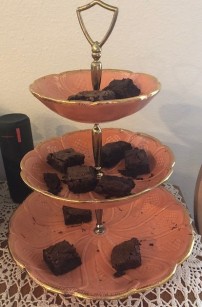 Oh, before I forget, here’s what’s left from today’s baking — that is, after distribution among neighbors!
Oh, before I forget, here’s what’s left from today’s baking — that is, after distribution among neighbors!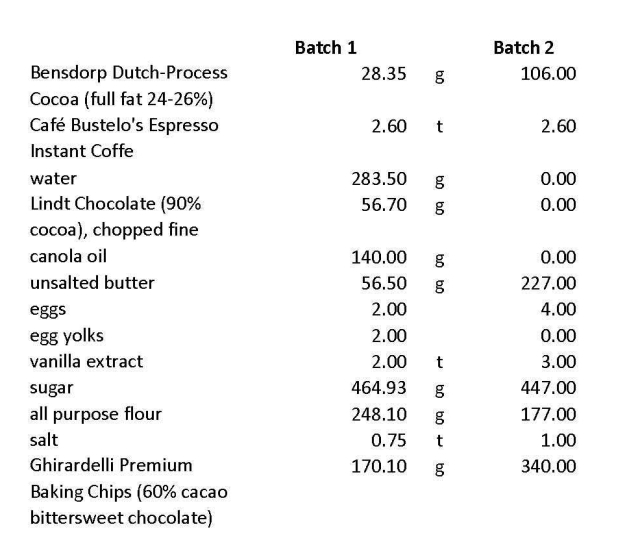





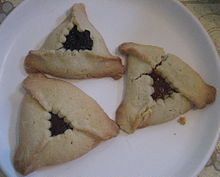 My friend K mentioned that she always loved the poppy seed filling of Hamantaschen but not its cookie dough. (
My friend K mentioned that she always loved the poppy seed filling of Hamantaschen but not its cookie dough. (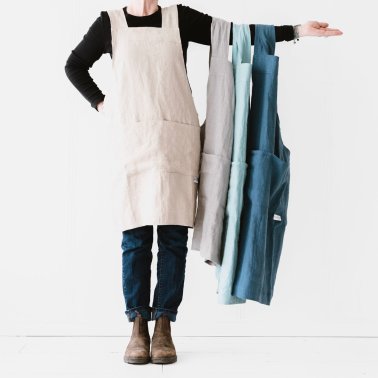 At any time I can be found puttering around the kitchen attending to artisan sourdough loaves, honing my weaving skills, or relaxing with knitting needles clicking under my fingers. So when my lover-of-aprons friend E (a skilled needle woman – not so much the knitting needle kind but the sewing and needlework kind), asked if I had seen the linen wrap pinafore aprons of
At any time I can be found puttering around the kitchen attending to artisan sourdough loaves, honing my weaving skills, or relaxing with knitting needles clicking under my fingers. So when my lover-of-aprons friend E (a skilled needle woman – not so much the knitting needle kind but the sewing and needlework kind), asked if I had seen the linen wrap pinafore aprons of  I’m not going to repeat what you can read or describe what you can see on Made on 23rd’s
I’m not going to repeat what you can read or describe what you can see on Made on 23rd’s 
 Second, you can select a hand-blocked design or none at all. You have a choice of a design on the pocket – Mod Flower (pic to the right), Pompom Dalia (pic on the aprons below), or Sunflower (pic on the apron above). Or you might o
Second, you can select a hand-blocked design or none at all. You have a choice of a design on the pocket – Mod Flower (pic to the right), Pompom Dalia (pic on the aprons below), or Sunflower (pic on the apron above). Or you might o pt for a row of flowers on the hem – Mixed Flowers (pic on top left), or Ball Flowers (pic on the bottom left).
pt for a row of flowers on the hem – Mixed Flowers (pic on top left), or Ball Flowers (pic on the bottom left). Fourth, they are made to be a comfortable fit for many sizes. They are made in two lengths (but the short length was still long enough for me to wear). A picture is often worth a thousand words …
Fourth, they are made to be a comfortable fit for many sizes. They are made in two lengths (but the short length was still long enough for me to wear). A picture is often worth a thousand words … In the picture t
In the picture t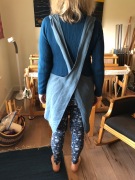 you can see the cross-back. (In retrospect, I should have worn something other than those silly patterned leggings [which I do not wear out of the house!].)
you can see the cross-back. (In retrospect, I should have worn something other than those silly patterned leggings [which I do not wear out of the house!].)
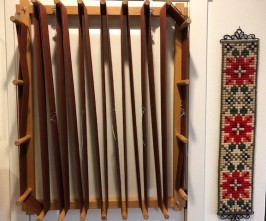 Soon K will learn how to warp a floor loom, specifically my 8-harness 55″ weaving width Gilmore. I’m almost done winding the warp (8/4 Maysville 100% cotton) for a couple of rugs. The piles of wool for wefts for several rugs have been staring at me reproachfully for the last year and a half. K’s fiber interest has at worst put me to shame and at best revitalized me!
Soon K will learn how to warp a floor loom, specifically my 8-harness 55″ weaving width Gilmore. I’m almost done winding the warp (8/4 Maysville 100% cotton) for a couple of rugs. The piles of wool for wefts for several rugs have been staring at me reproachfully for the last year and a half. K’s fiber interest has at worst put me to shame and at best revitalized me!






 Having arrived from
Having arrived from 











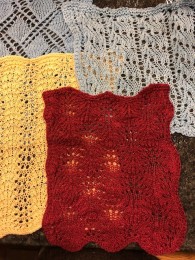 washcloths in smooth, multi-plied thin lace weight Eulali were my favorite. Peaches & Cream (I think it’s now Lily Sugar ‘n’ Cream) felt rough and thick, so I knit a very simple garter stitch cloth and another using a slip stitch pattern. Yuck. (They now sit in a kitchen drawer holding various hot pads and oven mitts.)
washcloths in smooth, multi-plied thin lace weight Eulali were my favorite. Peaches & Cream (I think it’s now Lily Sugar ‘n’ Cream) felt rough and thick, so I knit a very simple garter stitch cloth and another using a slip stitch pattern. Yuck. (They now sit in a kitchen drawer holding various hot pads and oven mitts.) I knit probably about two dozen washcloths – keeping a dozen for myself and distributing the rest as gifts. (By the way, a hand knit washcloth makes a lovely gift especially when wrapped around a bar of handmade goat milk soap!) Above are two pictures of washcloths I pulled out of the cupboard as I wrote this post.
I knit probably about two dozen washcloths – keeping a dozen for myself and distributing the rest as gifts. (By the way, a hand knit washcloth makes a lovely gift especially when wrapped around a bar of handmade goat milk soap!) Above are two pictures of washcloths I pulled out of the cupboard as I wrote this post. 